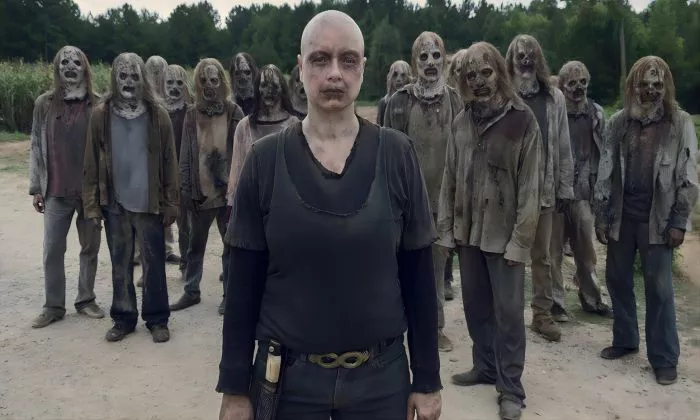Why Don’t They Eat Each Other?
“The Walking Dead” presents viewers with a grim depiction of a world overrun by zombies, known as walkers, who relentlessly pursue living humans in search of flesh. However, one puzzling aspect of walker behavior is their apparent aversion to consuming one another, despite their insatiable hunger for human flesh. In this article, we will explore the reasons behind this phenomenon, examining both narrative explanations within the series and real-world scientific considerations.
Narrative Explanations
From a narrative perspective, “The Walking Dead” offers several explanations for why walkers don’t eat each other, each of which contributes to the overarching themes and atmosphere of the series.
- Preservation of Instinct: One explanation for walker behavior is rooted in the preservation of instinct. In “The Walking Dead,” walkers are depicted as mindless creatures driven solely by their primal urge to feed on living flesh. However, this instinct appears to be selective, as walkers typically target living humans while showing little interest in consuming other undead. This preservation of instinct may be a narrative device used to heighten the sense of danger and suspense in the series, as it underscores the notion that walkers are fundamentally different from the living and poses a unique threat to survivors.
- Decay and Decomposition: Another explanation for walker behavior is tied to the physical deterioration of their bodies over time. In “The Walking Dead,” walkers are depicted as decaying corpses reanimated by an unknown virus or pathogen. As their bodies continue to deteriorate, walkers may become less appealing as food sources due to the presence of rot, decay, and other unpleasant factors. This decay and decomposition may serve as a natural deterrent to cannibalistic behavior among walkers, as they instinctively avoid consuming other undead in favor of fresher, more appealing prey.
- Narrative Conventions: Additionally, the decision to portray walkers as exclusively consuming living humans may be a narrative convention used to maintain tension and suspense within the series. By establishing a clear distinction between the living and the dead, “The Walking Dead” creates a sense of urgency and peril for its characters, who must constantly evade and outwit the undead to survive. Allowing walkers to consume one another would diminish the threat posed by the undead and detract from the central conflict of the series, which revolves around the struggle for survival against an overwhelming horde of flesh-hungry monsters.
Real-World Considerations
While the narrative explanations within “The Walking Dead” provide compelling reasons for why walkers don’t eat each other, there are also real-world considerations to take into account when exploring this phenomenon.
- Lack of Sustenance: From a physiological standpoint, the bodies of walkers may lack the necessary nutrients and sustenance to sustain other undead. In “The Walking Dead,” walkers are depicted as reanimated corpses with deteriorating bodily functions, including digestion and metabolism. Consuming other undead, which are similarly decayed and devoid of vital nutrients, would provide little nutritional value and may even be harmful to the consuming walker’s health. As a result, walkers may instinctively avoid cannibalism as a means of preserving their own well-being.
- Preservation of the Species: Another real-world consideration is the potential role of instinctual behavior in the preservation of the species. While walkers are depicted as mindless creatures driven by their primal urge to feed, they may still retain vestiges of their former humanity, including a subconscious aversion to consuming members of their own kind. This instinctual aversion to cannibalism may serve as a survival mechanism, preventing walkers from inadvertently wiping out their own species and ensuring the continuation of the undead population.
- Evolutionary Adaptations: Finally, the absence of cannibalistic behavior among walkers may be attributed to evolutionary adaptations that have emerged in response to the unique challenges of the post-apocalyptic world. As the dominant predator in their environment, walkers have likely developed behavioral and physiological traits that optimize their chances of survival, including a preference for consuming living humans over other undead. This evolutionary adaptation may have arisen over time as walkers adapted to their new ecological niche and competed with other predators for limited resources.
Conclusion
In conclusion, the question of why walkers don’t eat each other in “The Walking Dead” is a complex and multifaceted issue with both narrative and real-world implications. From a narrative perspective, walkers’ aversion to cannibalism serves to maintain tension and suspense within the series, while also underscoring their fundamental differences from the living. From a real-world standpoint, physiological and evolutionary factors may also play a role in shaping walker behavior, including the lack of sustenance provided by consuming other undead and the preservation of instinctual behaviors that optimize survival. Together, these considerations offer insight into the fascinating and often contradictory nature of walker behavior in “The Walking Dead,” adding depth and complexity to the series’ portrayal of the undead apocalypse.
https://www.rnada.com/archives/12522

